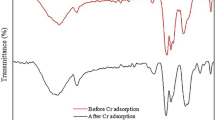Abstract
Oil spillage is an environmental challenge which involves the use of costly materials for its clean-up; emphasis is now on synthetic biodegradable materials for the clean-up. Natural rubber (NR) is a renewable polymer with high flexibility, making it a good adsorbent material. NR was modified by epoxidation to produce epoxidised natural rubber (ENR). NR and ENR were then modified with chitosan derived from land snail shell. The resulting composites were characterized by X-ray diffraction (XRD), scanning electron microscope (SEM) and used as sorbents for oil sorption. The results obtained from the sorption of gasoline and crude oil by the adsorbents through gravimetric method was in the order of 8.91 & 1.75, 10.71 & 1.58, 9.30 & 0.90, and 1.27: 0.38 g/g for NR, NR-C, ENR-C 4 h, ENR-C 6 h respectively. The broad peaks from EDX that appeared at 2θ of 10°, 24° for NR-C shows that it consists of amorphous region. The ENR-C 6 h showed a spongy surface morphology with good cross-linking. NR and NR-C displayed a better reusability when compared to other adsorbents. The results from the study of modified natural rubber-chitosan (MNR-C) demonstrated high potentials for remediation of oil contaminated water.









Similar content being viewed by others
References
Harpreet S, Neha B, Shailendra KA, Madhu K (2020) Environmental impacts of oil spills and their remediation by magnetic nanomaterials. Environ NanotechnolMonitManag 14:100305 (ISSN 2215-1532)
GPAC (Global Marine oil pollution Information Gateway) (2008) Effects of oil pollution on coastal habitats. http://oils.gpa-unep.org/facts/habitats.htm
NAS (US National Academy of Sciences) (2002) Oil in the Sea III: inputs, fates and effects. Report 2002 by the National Research Council (NRC) Committee on Oil in the Sea: Inuts, Fates, and Effects
Nwadiogbu JO, Ajiwe VIE, Okoye PAC (2016) Removal of crude oil from aqueous medium by sorption on hydrophobic corncobs: equilibrium and kinetic studies. J TaibahUnivSci 10:56–63
Badejo OT, Nwilo PC (2004) Management of oil spill dispersal along the Nigeria coastal areas. International Society for Photogrammetry and Remote Sensing, Congress, Istanbul
Junaid S, Muhammad AR, McKay G (2018) Oil sorbents from plastic wastes and polymers: a review. J Hazard Mater 34:424–437 (ISSN 0304-3894)
Hyung-Min C, Rinn MC (1992) Natural sorbents in oil spill clean-up. J Environ SciTechnol 26(4):772–776
Deschamps G, Caruel H, Borredon ME, Bonnin C, Vignoles C (2003) Oil removal from water by selective sorption on hydrophobic cotton fibres: study of sorption properties and comparison with other cotton fibre-based sorbents. J Environ SciTechnol 37(5):1013–1015
Annunciado TR, Sydenstricker THD, Amico SC (2005) Experimental investigation of various vegetable fibres as oil sorbent materials for oil spills. Mar Pollut Bull 50(11):1340–1346
Bayat A, Aghamiri SF, Moheb A, Vakili-Nezhaad GR (2005) Oil spill cleanup from seawater by sorbent materials. J ChemEngTechnol 28:1525–1528
Anh TH, Xuan DP (2018) An investigation of remediation and recovery of oil spill and toxic heavy metal from maritime pollution by a new absorbent material. J Mar EngTechnol. https://doi.org/10.1080/20464177
Tanasi P, Santana MH, Carretero-González J, Verdejo R, López-Manchado M (2019) Thermo-reversible crosslinked natural rubber: a Diels–Alder route for reuse and self-healing properties in elastomers. Polymer 175:15–24 (ISSN 0032-3861)
Davey JE, Loadman JR (1984) A chemical demonstration of the randomness of epoxidation of natural rubber. Br Polym J 16:134–138
Swarnalatha V, Dhamodharan R (2013) Epoxidized natural rubber-magnetite nanocomposites for oil recovery. J Mater Chem 1:868
Mohanasrinivasan V, Mishra M, Paliwal JS, Singh SK, Selvarajan E, Suganthi V, Devi CS (2014) Studies on heavy metal removal efficiency and antibacterial activity of chitosan prepared from shrimp shell waste. 3 Biotech 4:167–175
Struszczyk H (1987) Preparation and properties of microcrystalline chitosan. J ApplPolymSci 33:177–189
Coughlin RW, Deshaies MR, Davis EM (1990) Preparation of chitosan for heavy metal removal. Environ Prog 9:35–39
Sarbon NM, Sandanamsamy S, Kamaruzaman SFS, Ahmad F (2015) Chitosan extracted from mud crab (Scylla olivicea) shells: physicochemical and antioxidant properties. J Food SciTechnol 52(7):4266–4275
Martino AD, Sittinger M, Risbud MV (2005) Chitosan: a versatile biopolymer for orthopedic tissue engineering. Biomaterials 26:5983–5990
Donald LP, Gary ML, George SK, James RV (2013) Introduction to spectroscopy, 5th edn. Cengage Learning, Stanford, pp 29–71
Bangyekan C, Aht-Ong D, Srikulkit K (2006) Synthesis and characterization of chitosan from shrimp shells. CarbohydrPolym 63(1):61–71
Dawodu FA, Akpomie KG (2014) Simultaneous adsorption of Ni (II) and Mn (II) ions from aqeous solution into Nigerian Kaolinite clay. J Mater Res Technol 3(2):129–141
Temkin MI, Pyzhev V (1940) Kinetics of ammonia synthesis on promoted iron catalyst. ActaPhysicochim URSS 12:327–356
Aharoni C, Ungarish M (1977) Kinetics of activated chemisorption Part 2. Theoretical models. J ChemSoc Faraday Trans 73:456–464
Funding
This research did not receive any specific Grant from funding agencies in the public, commercial, or not-for-profit sectors.
Author information
Authors and Affiliations
Corresponding author
Ethics declarations
Conflict of interest
The author declare no conflicts of interest in the course of design, execution and writing of this article.
Rights and permissions
About this article
Cite this article
Mosaku, A.M., Akinlabi, A.K., Sojinu, O.S. et al. Adsorptive Remediation of Oil Spill Contaminated Water Using Chitosan Modified Natural Rubber as Adsorbent. Chemistry Africa 4, 535–543 (2021). https://doi.org/10.1007/s42250-021-00243-x
Received:
Accepted:
Published:
Issue Date:
DOI: https://doi.org/10.1007/s42250-021-00243-x




